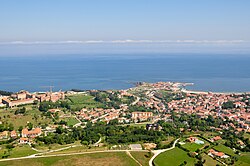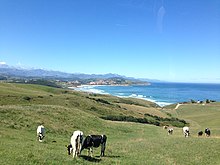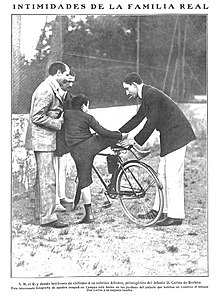Comillas
Comillas | |
|---|---|
 Aerial view of Comillas | |
 Location in Cantabria | |
| Coordinates:43°23′13″N4°17′22″W/ 43.38694°N 4.28944°W | |
| Country | |
| Autonomous community | |
| Province | Cantabria |
| Comarca | Western coast of Cantabria |
| Judicial district | San Vicente de la Barquera |
| Capital | Comillas |
| Government | |
| •Alcaldesa | María Teresa Noceda Llano (2007) (PRC) |
| Area | |
| • Total | 18.61 km2(7.19 sq mi) |
| Elevation | 23 m (75 ft) |
| Highest elevation | 210 m (690 ft) |
| Lowest elevation | 0 m (0 ft) |
| Population (2018)[1] | |
| • Total | 2,156 |
| • Density | 120/km2(300/sq mi) |
| Demonym(s) | Comillano, na |
| Time zone | UTC+1(CET) |
| • Summer (DST) | UTC+2(CEST) |
| Website | Official website |
Comillasis a small township andmunicipalityin the northern reaches ofSpain,in the autonomous community ofCantabria.TheMarquessate of Comillas,afiefdomofSpanish nobility,holds ceremonial office in the seat of power at a small castle which overlooks the town. TheComillas Pontifical Universitywas housed here before it moved to Madrid, and the old university buildings are among the finest examples of architecture in the town. Besides this, there are many notable medieval and baroque buildings.
From the second half of the 19th century, theSpanish royal familystarted spending their summers in Comillas, and so did a large part of theSpanish nobility,whose many descendants still frequent the town every summer.[2][3]As a result, Comillas left an imprint of architectural relics such as palaces and monuments designed by renownedCatalanartists in particular, i.e.GaudíorDoménech i Montaner.[4]From the second half of the 20th century however, southern Spain and the islands became more popular due to an increasing inclination towards sunnier destinations, and so places likeMarbella,SotograndeorMallorcabecame attractive prospects for the rich and famous.[5][6]Although the town has seen an upsurge in the last years, it still maintains its character as "the haven for the decadent and discreet aristocracy".[7][8]
Comillas was the capital of Spain for one day, on 6 August 1881, following an agreement between kingAlfonso XIIand the Minister's Council to gather at a formal meeting in town.[9]It also became the first place in Spain to useEdison'selectric light bulbs, in 1880.[10]
History
[edit]Comillas was first inhabited in prehistoric times when the caverns that are plentiful in the area were used as shelters. TheNeolithicinhabitants left behind them rock paintings that depicted the animals they hunted.[11]Magdalenian andBronze Ageartefacts have been found in nearby Ruiseñada, and there was an ancient mine at La Molina in which utensils and Roman coins have been found as well as an altar dedicated to the godJupiter.[12]Arrowheads have also been found here. On the border between Comillas and Ruiloba, heaps of shells have been found showing that the ancient people, besides hunting, specialised in collecting food from the sea.

The remains of the medieval castle of Peña del Castillo are still visible and another castle later occupied the same strategic site. The earliest documents relating to the town date to the eleventh century, although most of them were destroyed later in a fire at the town hall.Garcilaso de la Vegabuilt a tower on the coast to demonstrate the town's dominance in maritime affairs. After the conclusion of the Valles Lawsuit against the Duke of Infantado in 1581, Comillas became part of the Province of Nine Valleys, a judicial and administrative body. Historically, the town was one of four towns making up the Alfoz of Lloredo. The town is sometimes known as the "Town of the Bishops", because five priests who were born here went on to become bishops in several different dioceses during the Middle Ages.[13]
During the second half of the 19th century, the first Marquess Antonio López y López invitedKing Alfonso XIIto his mansion at Comillas and the town became popular with the aristocracy; the architectJoan Martorellbuilt the enormous Palacio de Sobrellano on the instructions of the marquess.[14]

Geography
[edit]Comillas is situated close to the coast in the autonomous community ofCantabria.To the north lies theBay of Biscayand to the south theCantabrian Mountainswhich run parallel with the coast, the highest point of which is theTorre de Cerredo,2,648 metres (8,688 ft).Santanderlies fifty kilometres to the east. There is a sandy beach and headlands and the town is set a little way back from the sea.[15]
Buildings
[edit]The Plaza del Corro de Campios, in the centre of the oldest part of the town, is surrounded by ancestral mansions with shields on the walls depicting the noble families who lived there. The town hall and the seventeenth century parish church of San Cristóbal are nearby,[13]and there are some interesting mausoleums in thecemetery.The Neo-Gothic university buildings overlook the town.[16]The Art Nouveau buildings are some of the finest in Cantabria and include the Sobrellano Palace Chapel, the Pantheon, andEl Capricho,a fantastic creation by the Catalan architectAntoni Gaudí.[17]
Marquess of Comillas
[edit]The first Marquess of Comillas wasAntonio López y López(died 1883). Founder and owner of theCompañía Transatlántica Española,he was born in Comillas in 1817 and made his money in Cuba in shipping and slaves. He bought the title in 1878.[18]The second Marquess of Comillas was his sonClaudio López Bru.The current Marquess of Comillas is Don Juan Alfonso Güell y Martos.
Gallery
[edit]-
Original complex of thePontifical University of Comillas
-
El Capricho,a building byAntoni Gaudí
-
Band of pipers playing in front of the palace of Sobrellano
-
Beach and port
-
Harbour
-
Playa de Oyambre
-
Church of San Cristóbal
-
Palace of theDukes of Almodóvar del Río
-
Casa Ocejo, current seat of theCount of Orgaz
-
El ángel exterminador,byJosep Llimona,one of the symbols of Comillas
-
View of a typical building of Comillas
References
[edit]- ^Municipal Register of Spain 2018.National Statistics Institute.
- ^Visit Spain: Comillas[permanent dead link]
- ^Martínez Tato, Marta:Verano de estilo - Como pasar por un veraneante más de Comillas- 22 July 2018
- ^Gistau, David:Comillas - la playa de los "papardos"- 25 July 2013 - ABC.es
- ^El Mundo:El turismo en España
- ^Diputación de Málaga:Historia de Marbella
- ^Ruisanchez, Guillem:Agosto en Comillas - Del marqués al IBEX 35- 22 July 2018
- ^Vanity Fair:Guía de Comillas, el veraneo más elegante- 22 July 2018
- ^"Town Hall of Comillas".
- ^"El Diario Montañés: El legado del marqués".
- ^Bernard Samuel Myers (1959).Encyclopedia of world art.McGraw-Hill. p. 38.
- ^PACT.Conseil de l'Europe, Council of Europe. 1990. p. 130.
- ^ab"Heritage in Comillas, Cantabria".Tourism Comillas.Retrieved2015-08-30.
- ^DK Eyewitness Travel Guide: Northern Spain: Northern Spain.Dorling Kindersley Limited. 1 May 2013. p. 104.ISBN978-1-4093-3105-6.
- ^Philip's Modern School Atlas.George Philip & Son. 1973. p. 37.ISBN0-540-05278-7.
- ^Greenwood, Margaret (1992).The Footloose Guide:Spain.Simon & Scuster. p. 259.ISBN0-671-71023-0.
- ^"The Town of Comillas: Cantabria".Tourism Comillas.Retrieved2015-08-30.
- ^Dana Facaros; Michael Pauls (1 March 2009).Northern Spain.New Holland Publishers. p. 203.ISBN978-1-86011-395-6.














